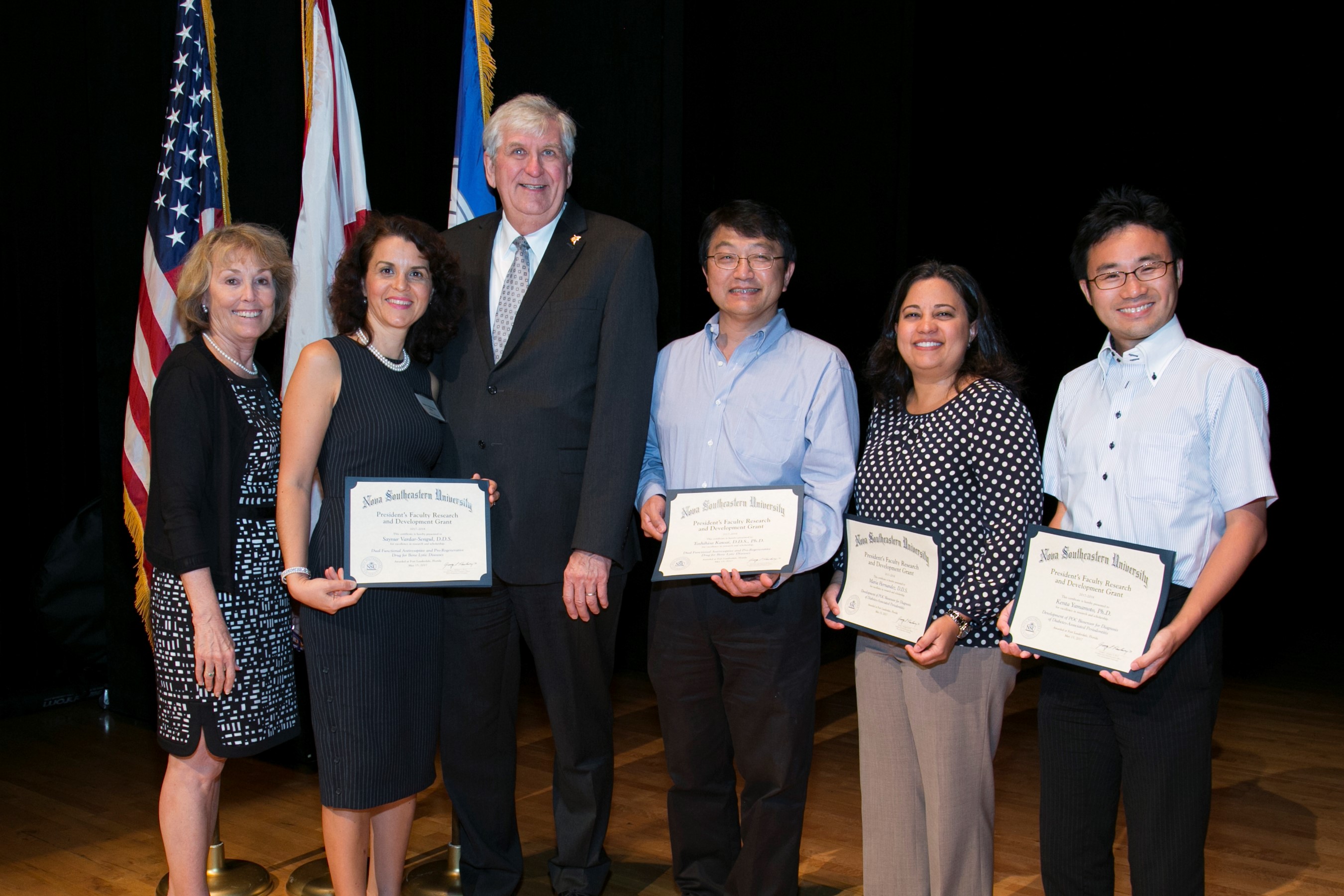Development of POC Biosensor for Diagnosis of Diabetes-Associated Periodontitis
Grant Winners
- Toshihisa Kawai, D.D.S., Ph.D. – College of Dental Medicine
- Maria Hernandez, D.D.S. – College of Dental Medicine
- Saynur Vardar-Sengul, D.D.S. – College of Dental Medicine
- Kenta Yamamoto, Ph.D. – College of Dental Medicine
- Gabriella Ambrose, B.S. – College of Dental Medicine
Dean
- Linda C. Niessen, D.M.D., M.P.H., M.P.P. – College of Dental Medicine
Abstract
 In order to maintain structural integrity of skeleton throughout life, bone remodeling is a physiological bone renewal process regulated by hormonal and molecular factors that control communication among local groups of bone cells, i.e., osteoclasts and osteoblasts, called bone multicellular units (BMU)1, 2 . However, lines of evidence support that a highly coordinated process of balanced bone resorption and formation mediated by BMU is disturbed (uncoupled) in periodontitis, an inflammatory bone lytic disease caused by polymicrobial infection. While RANKL produced by bacteria-reactive lymphocytes is known to cause osteoclast-mediated pathogenic periodontal bone loss3-6 , molecular mechanism underlying the impaired alveolar bone regeneration in the context of periodontitis remains elusive. Recent publications revealed that Semaphorin 4D (Sema4D) expressed by osteoclasts play a pivotal role in suppression of osteoblastogenesis in osteoporosis and cancer bone metastasis7, 8 . However, the expression pattern and roles of Sema4D in periodontitis remain elusive. In this regards, a novel class of chemically-modified curcumins, CMC 2.24, was reported to inhibit periodontal bone loss in the rodent (rat) model of periodontitis9, 10 . Based on the CMC 2.24’s chemical property that can inhibit the catalytic activities of a variety of metalloproteases (MMPs)10 , including MMP2, MMP8 and MMP9, that play pivotal roles in extracellular matrix destruction, the pathogenic bone resorption and inflammation induced in rat model of periodontitis is inhibited by CMC2.249, 10 . In contrast to such an established CMC2.24’s anti-inflammatory/anti-resorptive activity, it has not yet been determined whether CMC2.24 possesses a potency to restore the pathogenically impaired alveolar bone regeneration in periodontitis. Based on our preliminary findings that soluble Sema4D generated by sheddase MT1-MMP (MMP14) is more efficiently engaged in suppression of osteoblastogenesis than membrane-bound Sema4D, and the published reports demonstrating that CMC2.24 may neutralize MT1-MMP10, 11 , we hypothesize that a chemically modified curcumin, CMC2.24, can restore the pathogenically impaired alveolar bone regeneration by neutralizing MT1-MMP expressed on activated osteoclasts that sheds the membrane bound Smea4D and generates soluble Sema4D in periodontitis. To test above noted hypothesis, two aims are proposed. In Aim 1, we will evaluate whether CMC 2.24-mediated inhibition of MMPs, especially that of MT1-MMP, can suppress the generation of soluble Sema4D from osteoclasts in an in vitro model. Then, the impact of such a suppressed generation of soluble Sema4D by the osteoblastogenesis will be evaluated using co-culture between osteoclasts and MC-3T3E1 osteoblasts. In Aim2, the efficacy of systemically administered CMC2.24 to restore the new bone formation at the periodontal lesion induced in a mouse model of periodontitis will be evaluated by monitoring the activity of MT1-MMP and levels of sSema4D produced in diseased gingival tissue in comparison to other authentic anti-osteogenic factors, such as Sclerositin or Noggin.
In order to maintain structural integrity of skeleton throughout life, bone remodeling is a physiological bone renewal process regulated by hormonal and molecular factors that control communication among local groups of bone cells, i.e., osteoclasts and osteoblasts, called bone multicellular units (BMU)1, 2 . However, lines of evidence support that a highly coordinated process of balanced bone resorption and formation mediated by BMU is disturbed (uncoupled) in periodontitis, an inflammatory bone lytic disease caused by polymicrobial infection. While RANKL produced by bacteria-reactive lymphocytes is known to cause osteoclast-mediated pathogenic periodontal bone loss3-6 , molecular mechanism underlying the impaired alveolar bone regeneration in the context of periodontitis remains elusive. Recent publications revealed that Semaphorin 4D (Sema4D) expressed by osteoclasts play a pivotal role in suppression of osteoblastogenesis in osteoporosis and cancer bone metastasis7, 8 . However, the expression pattern and roles of Sema4D in periodontitis remain elusive. In this regards, a novel class of chemically-modified curcumins, CMC 2.24, was reported to inhibit periodontal bone loss in the rodent (rat) model of periodontitis9, 10 . Based on the CMC 2.24’s chemical property that can inhibit the catalytic activities of a variety of metalloproteases (MMPs)10 , including MMP2, MMP8 and MMP9, that play pivotal roles in extracellular matrix destruction, the pathogenic bone resorption and inflammation induced in rat model of periodontitis is inhibited by CMC2.249, 10 . In contrast to such an established CMC2.24’s anti-inflammatory/anti-resorptive activity, it has not yet been determined whether CMC2.24 possesses a potency to restore the pathogenically impaired alveolar bone regeneration in periodontitis. Based on our preliminary findings that soluble Sema4D generated by sheddase MT1-MMP (MMP14) is more efficiently engaged in suppression of osteoblastogenesis than membrane-bound Sema4D, and the published reports demonstrating that CMC2.24 may neutralize MT1-MMP10, 11 , we hypothesize that a chemically modified curcumin, CMC2.24, can restore the pathogenically impaired alveolar bone regeneration by neutralizing MT1-MMP expressed on activated osteoclasts that sheds the membrane bound Smea4D and generates soluble Sema4D in periodontitis. To test above noted hypothesis, two aims are proposed. In Aim 1, we will evaluate whether CMC 2.24-mediated inhibition of MMPs, especially that of MT1-MMP, can suppress the generation of soluble Sema4D from osteoclasts in an in vitro model. Then, the impact of such a suppressed generation of soluble Sema4D by the osteoblastogenesis will be evaluated using co-culture between osteoclasts and MC-3T3E1 osteoblasts. In Aim2, the efficacy of systemically administered CMC2.24 to restore the new bone formation at the periodontal lesion induced in a mouse model of periodontitis will be evaluated by monitoring the activity of MT1-MMP and levels of sSema4D produced in diseased gingival tissue in comparison to other authentic anti-osteogenic factors, such as Sclerositin or Noggin.